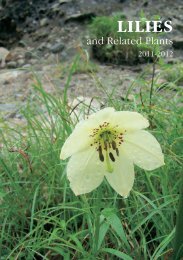LILIES - RHS Lily Group
LILIES - RHS Lily Group
LILIES - RHS Lily Group
Create successful ePaper yourself
Turn your PDF publications into a flip-book with our unique Google optimized e-Paper software.
century suggest otherwise as his ‘White Beauty’ is shown with a zone of purple<br />
markings in the centre of the flower whereas today’s has orange-brown markings;<br />
this discrepancy could however be due to the degree of accuracy of the original<br />
artwork and/or the quality of the colour printing in the catalogue.<br />
The other western North American species that produce offsets are<br />
E. tuolumnense and E. multiscapoideum, and it appears that the relative<br />
newcomer, E. taylori, might also behave in the same way. The yellow-flowered<br />
E. tuolumnense is a superb garden plant, rapidly forming clumps and with several<br />
bright yellow flowers in a raceme. It is little surprise that hybrids between it and<br />
‘White Beauty’ (‘Pagoda’ is the most widespread in cultivation) are even more<br />
prolific with offsets, although lacking some of the grace of both parents. The<br />
species is quite restricted in the wild so is unsurprisingly not strikingly variable<br />
but there are a few worthy of comment. Some plants of E. tuolumnense have<br />
noticeably undulate leaf margins, others slightly glaucous grey leaves instead<br />
of the usual clear, bright green. ‘Spindlestone Surprise’ is excellent, although to<br />
try to define in words exactly what it is that identifies the clone is difficult; the<br />
flower colour seems a rather clearer, brighter yellow and it is possibly flowers<br />
more freely. The exciting discovery E. taylorii, described in 1985, also appears<br />
to increase fairly well and consequently looks as if it might qualify as a ‘good<br />
garden plant’. Although not unlike E. tuolumnense in general appearance the<br />
flowers are white with large yellow centres, so large that one might equally refer<br />
to them as yellow with white tips to the tepals.<br />
The third of these ‘offset-producers’, E. multiscapoideum, has a choice of<br />
epithet I have always admired. It was chosen by the eminent nineteenth century<br />
American botanist Albert Kellogg and is exquisitely precise in its meaning; it<br />
distinguishes between ‘multi-flowered’ (there are several suitable epithets for<br />
this such as multiflorum, pluriflorum, polyanthum, etc.) a condition where there<br />
would be several flowers borne in a raceme on a common stem or scape (e.g.<br />
in some Erythronium, Fritillaria, Lilium) as opposed to ‘many-scaped’. In E.<br />
multiscapoideum the individual flower stalks (pedicels) are long and appear to<br />
arise at or below ground level thus giving the impression that each plant has<br />
more than one scape. This may not be apparent in weak or young plants which<br />
tend to have only one flower anyway. Although it appears that on publication<br />
the epithet was spelled multiscapideum (it was first described in 1855 in the<br />
genus Fritillaria) I wonder if that was just a ‘typo’ in the original manuscript<br />
for it doesn’t seem to mean anything in that form whereas the ‘-oideum’ suffix<br />
in multiscapoideum indicates ‘like’ or ‘as if’ many-scaped. All that aside, this is<br />
an attractive white-flowered species which produces stolons rather than offsets<br />
attached to the parent bulb so is more patch – than clump-forming. The variant<br />
from the Pulga Bridge area of Butte Co., California, loosely known as “Cliftonii”<br />
82




